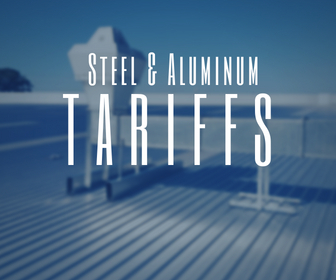
The US and China signed a phase-one trade agreement on January 15th to ease the ongoing trade war tensions, paving the way for another stage of trade negotiations. But it is only the start of negotiations to defuse a broader economic standoff between the two sides. The truce lowered rates on a portion of Chinese tariffs but left them on $360 billion worth of Chinese products. Under the phase-one deal, China agreed to purchase more American products and adjust the way its economy is managed. However, the agreement does not appear to affect the 25% tariffs applied to Chinese steel and aluminum early in the conflict.
At first, the tariffs were an instant bonanza for domestic steel producers. With much fanfare, some announced ambitious expansion plans. Today, the steel industry tells a different story. Steelmakers that once supported Trump’s steel tariffs have had a change of heart, and steel production has consecutively declined, resulting in several layoffs and cutbacks. A tariff is a tax, and if you tax an item the price of that item goes up, resulting in purchasers buying less of that item. And that’s what’s happening to the domestic steel industry today. U.S. manufacturing, which along with the construction sector is the principle consumer of American steel, is currently in recession.
For the HVAC industry, the trade war’s effect depends on which part of the industry is being asked. However, three statements earn broad agreement:
- Overall, the industry views the tariffs as bad for business and would like to see them disappear.
- The added cost of the steel and aluminum tariffs most relevant to HVAC pricing is being passed on to the consumer.
- American consumers, over the last several months, do not seem to be feeling this impact in a way that affects their purchasing decisions.
Air Conditioning Heating & Refrigeration Institute’s (AHRI) member survey indicated that 70 percent of its manufacturers have been affected by the pertinent tariffs. Customers are absorbing the brunt of these tariffs and contractors should mitigate damage to customer relations by communicating with customers about tariff realities, building quotes that reflect current realities, and considering force majeure clauses in contracts.
Residential HVAC
Luckily, the residential HVAC industry and their customers may have some inherent insulation from tariffs: infrequent nature of purchasing heating and/or air conditioning systems. Tariffs may make a new heating system 14 percent more expensive today than it was in 2017. That still might not affect the way a potential customer looks at pricing if they haven’t bought a unit since 2003. People in that situation know that the fix is relatively expensive but rare.
Commercial HVAC
While that may help contractors on the residential side, commercial HVAC contractors and their clients have had no such luck. Commercial work often means more lead time and more of a delay between a successful bid and the work itself. That increases the chances for an interim price hike due to tariff-induced increases in the cost of steel and other materials. The resulting spike in project cost can make for a displeased customer and an uncomfortable conversation.
With no relief from steel or aluminum tariffs visible in the near future, this may be a good time for a quick review of force majeure, which includes events such as acts of God, strikes, war or acts of the government, as something contractors’ contracts should include. Force majeure commonly comes up in relation to natural disasters, but it can represent some protection if the clause is included in a contract before a given tariff. If the problem is an existing tariff, then the best solutions may be pricing the tariff in originally and/or creating windows of pricing with some shared burden in the case of unexpected costs.
USMCA
China isn’t the only international trade and tariff hotspot with HVAC relevance these days. On December 19, 2019, the United States House of Representatives passed the USMCA with bipartisan support by a vote of 385–41. On January 16, 2020, the United States Senate passed the trade agreement by a vote of 89–10. The bill is now awaiting President Trump’s signature. Once Trump signs the USMCA implementation bill it will officially cancel NAFTA but not the 1989 Canada-US Free Trade Agreement, so in case parties fail to extend or renew it in 6 years, FTA would become the law. Once Donald Trump signs the USMCA implementation bill into law, NAFTA is officially cancelled but 1989’s Canada-US FTA would only be ‘suspended’
Conclusion
As details on the ‘Phase 1’ trade deal come rolling in, disappointment from the steel industry is apparent. Scott Paul, president of the Alliance for American Manufacturing, which includes manufacturers and the United Steelworkers union, said in a tweet, “All those ‘forgotten men and women’ in U.S. factories have, once again, been forgotten.” The administration has said it will address some of these changes in Phase 2 of the negotiations and is keeping tariffs in place in part to maintain leverage for the next round of talks. Mr. Trump said he would remove all tariffs if the two sides reach agreement on the next phase. The last chapter of the trade deal states that Washington and Beijing will agree on the timing of new negotiations — although no timeline is given. While fresh trade negotiations are expected to begin soon, Trump has said he would prefer to wait until after the November election to finalize another agreement.
FIELDBOSS stays current on industry trends to keep you informed on what’s happening in the HVACR world. Read our blog and sign up for our newsletter for all the latest news.
#Steelandaluminumtariffs #Tariff